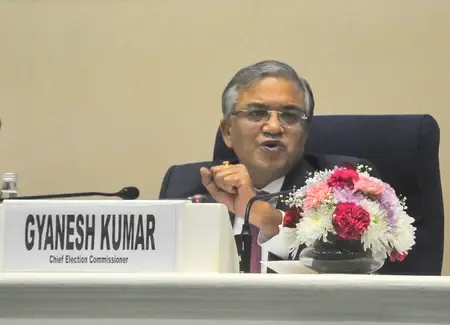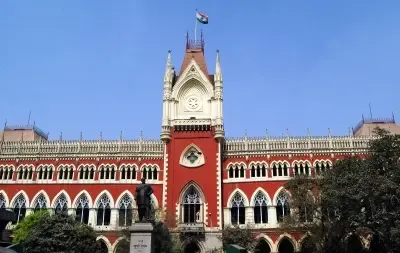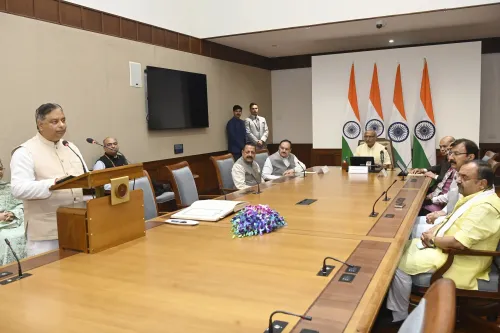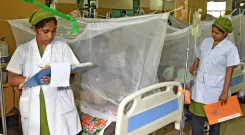Is There a Favorable Wind for the NDA?

Synopsis
Key Takeaways
- Optimism for NDA’s victory amid a focus on development.
- Increased female voter participation reflects societal change.
- Significant competition among major and smaller parties.
- The initial voter turnout indicates active engagement.
- Political stakes are high for both ruling and opposition coalitions.
Patna, Nov 6 (NationPress) As the first phase of the Bihar Assembly elections kicks off, Bihar Minister and JD(U) leader Ashok Choudhary, alongside LJP (Ram Vilas) MP Shambhavi Choudhary, expressed their optimism about the NDA's success, stating that there is a significant breeze blowing in support of the alliance. They emphasized that, for the first time, voters are prioritizing development over caste and creed.
In an interview with IANS, Ashok Choudhary remarked, “There is a noticeable wind in favor of the NDA. The people of Bihar are resolute in stopping the re-emergence of ‘Jungle Raj’ in the state. The trend appears favorable, and the aware voters of Bihar are endorsing development-focused politics. For the first time, individuals are voting beyond the confines of caste and religion.”
Shambhavi Choudhary added, “I have cast my vote and encourage all citizens of Bihar to participate in the voting process in large numbers. Voting is not only our fundamental right but also our constitutional obligation. The choices we make today will influence the future of our state and our nation.”
She further highlighted the significant increase in female voter turnout, particularly in rural areas.
“Women are showing up in substantial numbers at polling stations, which beautifully illustrates a transforming Bihar. There is strong assurance that the NDA will reclaim power with a full majority,” she mentioned to IANS.
“This is a pivotal day for making decisions. I earnestly urge everyone to go out and vote. The choice of whom to vote for is secondary; what truly matters is that you engage and ensure that your ideology prevails,” she added.
As per the Chief Electoral Officer, an average voter turnout of 27.65 percent was recorded by 11 a.m. on Thursday across 18 districts participating in the initial phase of the Bihar Assembly elections.
The first phase of these elections commenced with over 3.75 crore voters determining the fate of candidates in 121 constituencies out of a total of 243 seats. This phase is particularly crucial for the Opposition Mahagathbandhan (Grand Alliance), which secured 63 of these seats in the 2020 elections. The ruling National Democratic Alliance (NDA)—comprising the BJP and JD(U)—held 55 seats in these constituencies.
This round of voting is also essential for smaller parties allied with both major coalitions. The Communist Party of India (Marxist–Leninist) or CPI(ML), which had one of the highest strike rates in 2020, will have 10 of its 20 contested seats up for election in this phase. The party currently holds six of these seats. Retaining these constituencies is crucial for the CPI(ML) to maintain its previous electoral performance.
Within the NDA, the LJP(RV) led by Chirag Paswan is contesting 29 seats across Bihar, with 10 of them in this first phase. Remarkably, the NDA currently holds only one of these ten seats. The LJP(RV)’s allocation of seats had earlier caused tensions among alliance partners, especially the JD(U), which believed the distribution did not reflect the LJP(RV)’s current strength in the Assembly.
The Vikasheel Insaan Party (VIP), now part of the Mahagathbandhan, will also be tested on its electoral strength. Out of the 15 seats it is contesting, six will be voted on in this initial phase. The alliance has named VIP chief Mukesh Sahani as its Deputy Chief Ministerial candidate, raising the stakes for his party’s performance.
A number of prominent figures are competing in this phase. Tejashwi Yadav, the Opposition’s chief ministerial candidate and RJD leader, will run alongside over a dozen ministers from the Nitish Kumar-led NDA government.
Among these are Deputy Chief Ministers Samrat Choudhary and Vijay Kumar Sinha. Notably, Choudhary is contesting a direct election after nearly a decade from Tarapur, while Mangal Pandey, a former Bihar BJP president and current minister, is vying for his first Assembly election from Siwan.
This phase also features several celebrities and public figures, adding glamour to the political contest. Young folk singer Maithili Thakur is running on a BJP ticket from Aliganj, while Bhojpuri cinema star Khesari Lal Yadav represents the RJD in Chhapra. Another Bhojpuri actor, Ritesh Pandey, is contesting from Kargahar as a candidate of the Jan Suraaj Party led by political strategist Prashant Kishor.
Another subplot involves Tejashwi Yadav's elder brother, Tej Pratap Yadav, who has formed his party, the Janshakti Janata Dal. He is contesting from Mahua, a seat he previously held. This contest will reveal whether he can establish an independent political identity or remain overshadowed by his younger brother’s leadership in the RJD.
Several high-profile and sensitive constituencies are attracting notable attention. In Mokama, JD(U)’s Anant Singh, currently in custody related to a murder case, faces Veena Devi of the RJD, wife of former MP Suraj Bhan, who also has multiple charges against her.
Another intriguing contest is in Raghunathpur, where Osama Shahab, son of the late gangster-turned-politician Mohammad Shahabuddin, is running on an RJD ticket.
According to the Election Commission of India (ECI), voting will occur at 45,341 polling stations, with 36,733 of them located in rural areas, underscoring Bihar’s predominantly agrarian character. Among the 3.75 crore registered voters, 10.72 lakh are first-time voters, and 7.38 lakh fall within the 18-19 age group.
As the first phase of Bihar polls progresses, all attention will be on whether the Opposition can maintain its strongholds from 2020 or if the ruling alliance can reclaim lost ground. The outcome of this first phase is poised to set a precedent for the upcoming rounds of polling and could significantly influence the state’s political landscape for the next five years.









